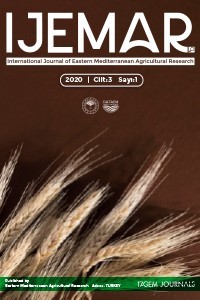Investigation of Second Crop No-Tilled Soybean Crop Performance in Kiziltepe Conditions of Turkey
Soybean, second crop, no-till, drip irrigation
___
- Adee, E. A., Oplinger, E. S., Grau, C. R.(1994). Tillage, rotation sequence, and cultivar influences on Brown Stem Rot and soybean yield. Journal of Production Agriculture 7, 341-347.
- Derpsch, R. (1998). Historical review of no-tillage cultivation of crops, JIRCAS Working Rep. 13:1–18., Japan Int. Res. Ctr. for Agric. Sciences, Ibaraki, Japan.
- Dick, WA., Van Doren, D. M. Jr. (1985). Continuous tillage and rotation combinations effects on corn, soybean, and oat yields. Agron J 77:459–465.
- Erbil, E. and Gür, M.A. (2017). Investigation of Performance of Some Advanced Soybean Lines at Şanlıurfa Second Crop Conditions Using Physiological and Morphological Parameters Regarding Traits of Yield. Harran Tarım ve Gıda Bilimleri Dergisi (2017) 21(4): 480-493.
- Griffith, D. R., Kladivko, E.J., Mannering, J. V., West, T. D., Parsons, S. D. (1988). Long-term tillage and rotation effects on corn growth and yield on high and low organic matter poorly drained soils, Agron. J. 80:599–605.
- Oryokot, J. O. E.(1997). Effect of tillage and corn on pigweed (Amaranthus spp.) seedling emergence and density, Weed Sci. 45:120–126.
- Sevilmis, U., Kahraman, S., & Karademir, E.(2014). Investigation of Yield and Quality Characteristics of Some Commercial Soybean Varieties under No-Tilled Second Crop Conditions in Diyarbakır.International Mesopotamia Agriculture Congress, 22-25 September, Abstract Book, Oral Presentations, s,15, Diyarbakır – Turkey.
- Swanton, C. J., Murphy, S. D.(1996). Weed science beyond the weeds: The role of integrated weed management (IWM) in agroecosystem health, Weed Sci. 44:437–445.
- TUİK.(2014). Turkish statistical Institute. http://www.tuik.gov.tr/bitkiselapp/ access date: 04.03.2015.
- Vyn, T. J., Opoku, G., Swanton, C. J. (1998). Residue management and minimum tillage systems for soybean following wheat, Agron. J. 90:131–138.
- Yıldırım, A. and Ilker, E. (2018). Determination of Yield and Important Agronomic Traits and Quality Traits of Some Soybean Varieties and Lines Grown Under Second Crop Condition in The Aegean Region. ADÜ ZİRAAT DERG, 2018;15(2):1-8.
- ISSN: 2667-5102
- Yayın Aralığı: Yıllık
- Başlangıç: 2018
- Yayıncı: Eastern Mediterranean Agricultural Research Institute
Mehmet KÜÇÜKYILMAZ, Gürel NEDİM ÖRNEKCİ, Ali ATİLLA USLU, Nevin BİRİCİ, Tunay ŞEKER, Nurten ÖZBEY
Endonezya’da Melez Çeltik Yetiştiriciliği: Genel bir Değerlendirme
Achmad YOZAR PERKASA, Khalid Mahmood KHAWAR BHATTİ, Hakan ULUKAN
Sığır Embriyolarının Gelişim Evreleri ve Kalite Değerlendirilmesi
Türkiye’de Özel Mısır Tiplerinin Kullanımı ve Geleceği
Ahmet ÖZTÜRK, Erkan ÖZATA, Şekip ERDAL, Mehmet PAMUKÇU
Investigation of Second Crop No-Tilled Soybean Crop Performance in Kiziltepe Conditions of Turkey
Şerif KAHRAMAN, Uğur SEVİLMİŞ, Halil KARAHAN
Organik Tarım Tartışması: Bir Literatür İncelemesi
